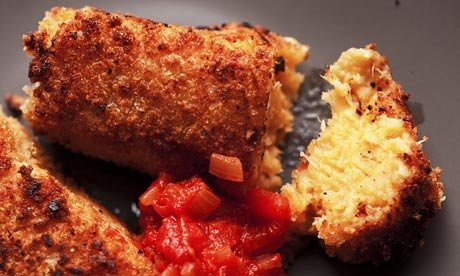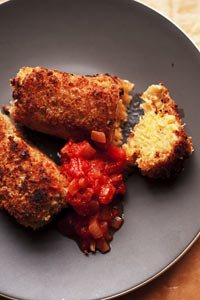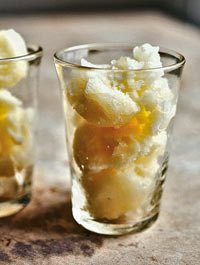Nigel Slater's croquettes and sorbet recipes

Anyone for croquettes? Parsnip and potato croquettes. Photograph: Jonathan Lovekin for the Observer
Olive oil, salt and black pepper aside, there are few ingredients that I regard as absolute essentials. Sure, there are a few things that are always in my fridge, not because I regard them as "essentials" but more because they seem to have taken up residence. A jar each of apple and tomato chutney, some disappointingly sweet mulberry jam, a tub of sweet miso that I use as stock base for soup, and a tube of wasabi. They have been housemates for so long now my fridge wouldn't be the same without them. There are also a few root vegetables, a can of tomatoes, a logjam of lemons and a loaf that has seen better days.
In the absence of a star ingredient, the root vegetables will have to be the principal part of tonight's meal. They have played this role before, in a parsnip and celeriac gratin, the dear old Parsnips Molly Parkin – a 70s dish of sliced root vegetables, cream and tomatoes – and as a root vegetable korma. But these were recipes I had deliberately shopped for – and tonight's dinner is led by desperation.
The potatoes and parsnips are steamed and mashed; the tomatoes end up as a quick, make-do sauce with onions and sherry vinegar. The mash is patted into fat sausages and fried as croquettes. To make the most of the parsnips' sweetness, I fry them after steaming them in butter and spice. This gives their natural sugars a chance to shine and lends a deeper flavour to the mash; you can make a perfectly fine croquette with mashed potatoes and parsnips, but having done it, I think it was worth the trouble.
Making a mash that is firm enough to hold its shape is less easy with some root vegetables than others. Celeriac, carrots and parsnips all produce a softer, purée-style mash than potatoes, so I steam them rather than let them cook in water. A drier result will give you a croquette or fritter that is less likely to collapse on final cooking. A while in the fridge to firm up might be frustrating when we are waiting for our dinner, but will help the fritters keep their shape.
The traditional way of finishing any breadcrumb- or batter-coated croquette is to deep-fry it. I am not fond of this method of cooking at home and tend to leave it to others. With a large piece of food such as mashed potato or parsnip cake it is possible to shallow-fry it in a very thin film of oil, then finish it in the oven.
For dessert, the lemons caught my eye. Quite a stock of them had built up – enough to get plenty of juice for a lemon meringue pie, a posset or a syllabub. Instead, I turned them into a water ice – something shudderingly sharp and refreshing for a cold day. It was like eating lemon-scented snow. Not bad for a bare cupboard.
Parsnip and potato croquettes
-
Makes 8, serves 4
- parsnips 350g
- potatoes 500g
- butter a thick slice
- ground cumin 1 tsp
- hot smoked paprika 1 tsp
- eggs 2, beaten
- breadcrumbs 150g, fresh and white
-
For the sauce:
- onion 1
- olive oil 2 tbsp
- canned chopped tomatoes 400g
- sherry vinegar 1 tbsp
- sugar 2 tsp

Parsnip and potato croquettes. Photograph: Jonathan Lovekin for the Observer
Peel the parsnips and potatoes and cut them into large pieces. Steam separately (they are unlikely to take the same time to cook), then remove from the steamer.
Melt the butter in a shallow pan over moderate heat, then add the cumin, paprika, potatoes and parsnips. Let them fry for 10 minutes, until lightly golden here and there. Season with salt and black pepper then crush with a potato masher or fork. Beat for a minute or two with a wooden spoon, then allow to cool until comfortable to handle.
Take scoops of the mash and pat them into fat cylinders about 5 or 6cm long. You will get about 8 of them, enough for 2 each. Put them on a lightly oiled or floured plate and refrigerate for an hour to firm up.
Set the oven at 200C/gas mark 6. Put the egg on a saucer and the breadcrumbs on a plate. Lower the croquettes, one at a time, into the egg, roll them over so they are coated, then drop them into the breadcrumbs. Turn each one, patting the crumbs all over. Remove and place on a plate.
Warm a layer of oil in a nonstick frying pan. When it is hot, lower the croquettes in a few at a time and cook until golden. As each is ready, lift on to an ovenproof dish and bake for 15 to 20 minutes until hot throughout. Serve with the sauce.
To make the tomato sauce, peel the onion, finely chop and cook in the oil until soft and pale gold. Tip in the tomatoes, vinegar, sugar, salt and black pepper, and simmer for 15 minutes.
Seriously lemony sorbet
I also use the stunningly scented bergamot lemons for this. Difficult to find, but worth a go if you spot them.
- sugar 100g
- water 200ml
- lemon juice 400ml

Seriously lemony sorbet. Photograph: Jonathan Lovekin for the Observer
Put the sugar and water into a saucepan and warm over a moderate to high heat until the sugar has dissolved. There is no need to boil this down to thick syrup, just make sure there is no undissolved sugar in it. Leave to cool then chill in the fridge. To bring the temperature down quickly, put the saucepan in a sink full of cold water and leave until cool, then chill as usual. You won't need all of this mixture, but it is best to make this amount so you can sweeten your sorbet to taste.
Pour the lemon juice into 100ml of the sugar syrup. It will be seriously sharp and refreshing. If you can't handle this, then add more sugar syrup to taste. Either pour the mixture into an ice-cream maker or freeze by hand. If you are taking the latter option, pour the mixture into a freezer box and freeze for 3 or 4 hours until ice crystals are forming around the edge. Beat them into the liquid centre until you have a sort of lemon slush, then freeze again for a couple of hours and, once again, beat the mixture and freeze again. This beating will help the structure of the sorbet and stop it freezing into a solid block, though the texture will be far from that of sorbet made in a machine.
Once it is frozen, leave it to soften slightly before serving. I like mine in rough, snowy lumps rather than neat scoops.
Email Nigel at nigel.slater@observer.co.uk or visit theguardian.com/profile/nigelslater for all his recipes in one place